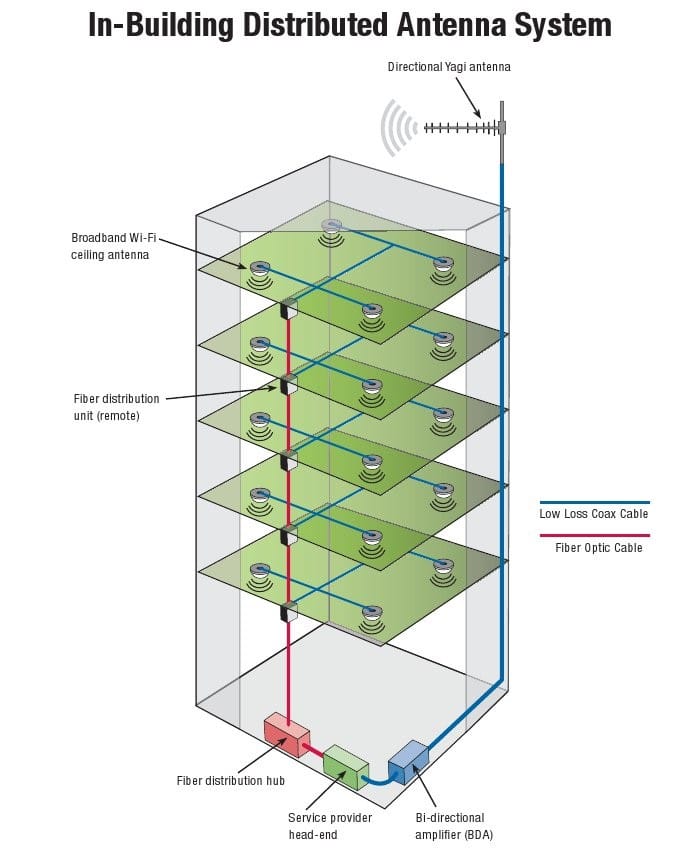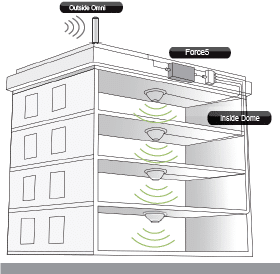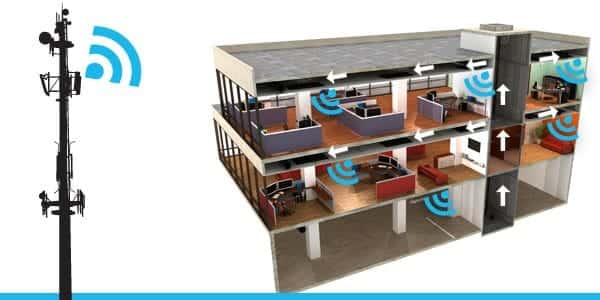By Dean A. Reskevich RCDD
VP Low Voltage Technologies, Taylored Systems
What Is a DAS System?
A distributed antenna system (DAS) is a network of spatially or geographically separated antenna nodes. These nodes are connected to a common source through a transport or communication medium in order to provide wireless communication service in a specific locality or building. A DAS Network can be deployed indoors to provide network or cellular connectivity throughout a building or outdoors in areas where regular wireless coverage does not reach.
A distributed antenna system is a way to extend the coverage of a given network such as a cellular network or wireless computer network. All of the antennas in a DAS installation are spaced from each other in such a way that each one is able to give full coverage without much overlap with the coverage areas of other antennas, minimizing the number of antennas required to cover a specific area.
All of the antennas in a DAS are simply extenders for signal coverage and are connected to a central controller that, in turn, is connected to a carrier’s base station. The RF spectrum covered by a DAS is licensed to wireless carriers, so enterprises cannot deploy a DAS on their own and must always involve a carrier, making the deployment the most expensive phase of a DAS project.
A DAS can be either passive or active. A passive DAS simply takes wireless signals from an antenna and then runs them through “leaky” feeder cables that act as antennas all over the building; the signal leakage distributes the signals. An active DAS takes the wireless signals from an external antenna and passes them to other antennas through fiber cables while being boosted and amplified via a cell phone signal amplifier along the way.
Costs for an installed DAS system can range from $1.50 to as high as $3.00 per Square Foot.
How It Works
Well, for one, the mere presence of additional antennas increases the chance of a good line-of-sight channel. The drop in power consumption has a slightly more complicated, less intuitive answer. Providing cellular signals is a power hungry task, often because of signal losses due to penetration and shadowing. To overcome these feeder losses, a DAS can use either a configuration of passive splitters and feeders, or active-repeater amplifiers. In short, this type of configuration introduces efficiency into the system that wouldn’t otherwise be there, and thus results in less power being used. Because DAS antenna node installations are compact, they can be deployed indoors and outdoors. Their size and power requirements also allow their installation in areas where traditional cell towers cannot be placed due to zoning restrictions. DAS systems may be tied to a particular wireless carrier, such as AT&T or Verizon, but the best bang for your buck is a neutral-host provider that can work with multiple carriers.

What is a Cell Phone Signal Booster?
Cell phone signal boosters (also known as cell phone antenna boosters) were developed to address the two factors that cause poor cell phone reception. They’re designed to amplify a weak outside signal and bypass any obstructions to provide a strong inside signal to an area that was originally lacking.
The system works by mounting an outside antenna in a location that currently has signal, which is typically on the roof. The signal is passed from the outside antenna, by a cable to a signal amplifier inside the building. Once the signal is amplified, it is then sent to an inside antenna, where it is broadcast out to the area which needs better reception. The system also works in reverse, with the signal from your phone being amplified and broadcast back to the tower, ensuring strong, two-way communication.


Losing signals in commercial office building has been an issue since the handheld cellular device came on the market. A recent survey by the Pew Internet and American Life project found that 72% of Americans experience some form of dropped calls, and 32% experience dropped calls at least a few times per week or more. Like it or not, dropped calls are still a major problem for a large number of people, and while the carriers are continuing to add towers and expand coverage areas, this is not a problem that’s going to go away soon. So what is there to do?
After years of research into this problem, the FCC formally approved the use of cell phone antenna boosters to extend the range of cell networks into areas that receive poor service, including homes, offices, commercial buildings and more. We’ll take a closer look at what cell phone antenna boosters are and give some guidance on how to choose the right system to permanently solve your reception problems.
Obstructions Causing Interference
While cell signal passes through the air with minimal trouble, every object it meets between the tower and your mobile device causes some degree of interference. Geographical elements, such as hills, mountains, and trees can cause major signal issues, as well as building materials, like metal siding, concrete, and wire mesh. Additionally, the increased use of energy efficient products, such as radiant barriers and window tinting, have contributed to the degree of cell phone reception problems in new homes.
While either one of these factors are enough to cause dropped calls and poor reception, the combination of the two all but guarantees problems. Next we’ll look at how a cell phone signal booster is designed to deal with both of these factors.
How to Choose an Antenna Booster
In order to select the correct cell phone antenna booster for your situation, you need to know the following three pieces of information: The carriers & networks that you need to support, the existing outside signal strength of those carriers, and the size of the area that needs to be covered in boosted signal. Let’s review those in more depth:
Carriers & Networks to Support
Cell phone antenna boosters only amplify specific frequencies of radio waves, which pertain to specific carriers (AT&T, Verizon, Sprint, etc.) and networks on those carriers (2G, 3G, or 4G LTE). The first thing you need to know is which carrier(s) you need to support, as well as which networks are on those carriers, as that determines which signal amplifiers you’ll be able to use and which type of outside antenna you’ll need.
Most North American carriers (except for T-Mobile and Nextel) use the same frequencies for 2G and 3G networks (which handle voice calls and 3G data), so the same signal amplifier can be used to amplify all of those carriers at the same time. The 4G LTE networks (which currently only handle fast data, no voice) on each carrier use different frequencies, so if you want to boost 4G LTE, then you’ll need an amplifier that is specifically designed for that carrier’s 4G LTE network.
In addition, if you need to support multiple carriers, then you’ll want to use an omnidirectional (omni) outside antenna, which can send and receive from all directions at once. If you only need to support one carrier, then you can use a stronger yagi directional antenna, which you can aim at the closest cell tower and receive more boosting power than you would receive from an omni antenna.
Outside Signal Strength
The outside signal strength of the carriers you need to support determines how strong of an amplifier you need to provide adequate coverage. The weaker the outside signal is, the stronger the cell phone signal booster needs to be in order to boost the signal and provide adequate coverage.
Area that Needs Coverage
The last piece of information that will determine which type of signal booster you need is the size of the area that needs to be covered in boosted signal, as well as the layout of the area. The combination of outside signal strength and the size of the area to be covered will determine how strong of an amplifier you’ll need.
In addition, the layout of the area to be covered will determine which type of inside antenna you’ll need. If the entire coverage area is located on one floor, then a dome antenna will be the best choice for distributing the boosted signal, but if the coverage area is over multiple floors, then you’ll want to go with a panel antenna, which is more directional and can be used to ensure signal is distributed across the required area.
Costs for an installed cell phone booster can range in price from $.50 to $.75 per square foot making it much more affordable than a DAS System but this also depends on the application and the size of your facility.
DAS vs. Repeaters / Boosters
Cell phone signal boosters take an existing cellular signal, amplify it, and then broadcast it. Boosters require an existing signal because they are unable to create their own signals, making them fundamentally different technology than DAS. Since boosters require an existing, stable signal in order to work, they cannot be placed in areas with very poor reception.
Let’s say you have a college campus located in a hilly area just outside a mid-sized city. The part nearest the city (Area A) receives an adequate signal, but the new set of dorms on the opposite side (Area B) has terrible service. Installing boosters in Area B would do no good because the acquired signal wouldn’t be strong enough for a boost. It’s not quite as simple a concept as multiplying by zero, but that may help to frame it.
You could, however, install boosters in Area A. This would amplify reception for Area A and it might help Area B as well. However, the same changes in terrain between the two zones would degrade the boosted signal as well.
So, the best way to fix reception in Area B would be to install a DAS because it would generate its own signal.
Understanding the basics of how a cell phone signal booster works and what you need to think about when purchasing one is a huge first step in determining the right system for you. Every situation is different, from the local geography to the construction of the house or building, so if you have the opportunity, consult with representative at Taylored Systems as to what system is best for you.

